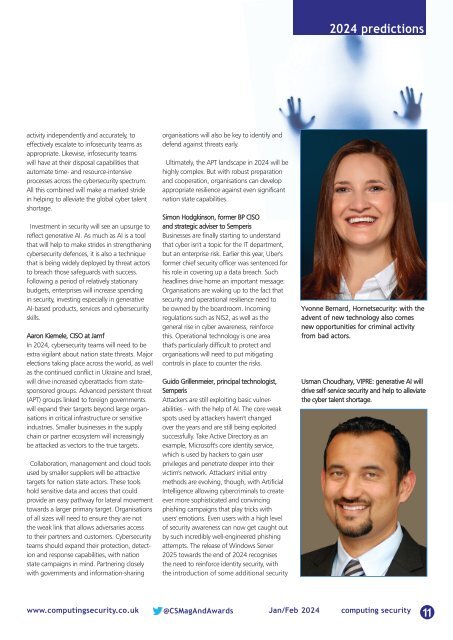CS Jan-Feb 2024
Create successful ePaper yourself
Turn your PDF publications into a flip-book with our unique Google optimized e-Paper software.
<strong>2024</strong> predictions<br />
activity independently and accurately, to<br />
effectively escalate to infosecurity teams as<br />
appropriate. Likewise, infosecurity teams<br />
will have at their disposal capabilities that<br />
automate time- and resource-intensive<br />
processes across the cybersecurity spectrum.<br />
All this combined will make a marked stride<br />
in helping to alleviate the global cyber talent<br />
shortage.<br />
Investment in security will see an upsurge to<br />
reflect generative AI. As much as AI is a tool<br />
that will help to make strides in strengthening<br />
cybersecurity defences, it is also a technique<br />
that is being widely deployed by threat actors<br />
to breach those safeguards with success.<br />
Following a period of relatively stationary<br />
budgets, enterprises will increase spending<br />
in security, investing especially in generative<br />
AI-based products, services and cybersecurity<br />
skills.<br />
Aaron Kiemele, CISO at Jamf<br />
In <strong>2024</strong>, cybersecurity teams will need to be<br />
extra vigilant about nation state threats. Major<br />
elections taking place across the world, as well<br />
as the continued conflict in Ukraine and Israel,<br />
will drive increased cyberattacks from statesponsored<br />
groups. Advanced persistent threat<br />
(APT) groups linked to foreign governments<br />
will expand their targets beyond large organisations<br />
in critical infrastructure or sensitive<br />
industries. Smaller businesses in the supply<br />
chain or partner ecosystem will increasingly<br />
be attacked as vectors to the true targets.<br />
Collaboration, management and cloud tools<br />
used by smaller suppliers will be attractive<br />
targets for nation state actors. These tools<br />
hold sensitive data and access that could<br />
provide an easy pathway for lateral movement<br />
towards a larger primary target. Organisations<br />
of all sizes will need to ensure they are not<br />
the weak link that allows adversaries access<br />
to their partners and customers. Cybersecurity<br />
teams should expand their protection, detection<br />
and response capabilities, with nation<br />
state campaigns in mind. Partnering closely<br />
with governments and information-sharing<br />
organisations will also be key to identify and<br />
defend against threats early.<br />
Ultimately, the APT landscape in <strong>2024</strong> will be<br />
highly complex. But with robust preparation<br />
and cooperation, organisations can develop<br />
appropriate resilience against even significant<br />
nation state capabilities.<br />
Simon Hodgkinson, former BP CISO<br />
and strategic adviser to Semperis<br />
Businesses are finally starting to understand<br />
that cyber isn't a topic for the IT department,<br />
but an enterprise risk. Earlier this year, Uber's<br />
former chief security officer was sentenced for<br />
his role in covering up a data breach. Such<br />
headlines drive home an important message:<br />
Organisations are waking up to the fact that<br />
security and operational resilience need to<br />
be owned by the boardroom. Incoming<br />
regulations such as NIS2, as well as the<br />
general rise in cyber awareness, reinforce<br />
this. Operational technology is one area<br />
that's particularly difficult to protect and<br />
organisations will need to put mitigating<br />
controls in place to counter the risks.<br />
Guido Grillenmeier, principal technologist,<br />
Semperis<br />
Attackers are still exploiting basic vulnerabilities<br />
- with the help of AI. The core weak<br />
spots used by attackers haven't changed<br />
over the years and are still being exploited<br />
successfully. Take Active Directory as an<br />
example, Microsoft's core identity service,<br />
which is used by hackers to gain user<br />
privileges and penetrate deeper into their<br />
victim's network. Attackers' initial entry<br />
methods are evolving, though, with Artificial<br />
Intelligence allowing cybercriminals to create<br />
ever more sophisticated and convincing<br />
phishing campaigns that play tricks with<br />
users' emotions. Even users with a high level<br />
of security awareness can now get caught out<br />
by such incredibly well-engineered phishing<br />
attempts. The release of Windows Server<br />
2025 towards the end of <strong>2024</strong> recognises<br />
the need to reinforce identity security, with<br />
the introduction of some additional security<br />
Yvonne Bernard, Hornetsecurity: with the<br />
advent of new technology also comes<br />
new opportunities for criminal activity<br />
from bad actors.<br />
Usman Choudhary, VIPRE: generative AI will<br />
drive self-service security and help to alleviate<br />
the cyber talent shortage.<br />
www.computingsecurity.co.uk @<strong>CS</strong>MagAndAwards <strong>Jan</strong>/<strong>Feb</strong> <strong>2024</strong> computing security<br />
11
















